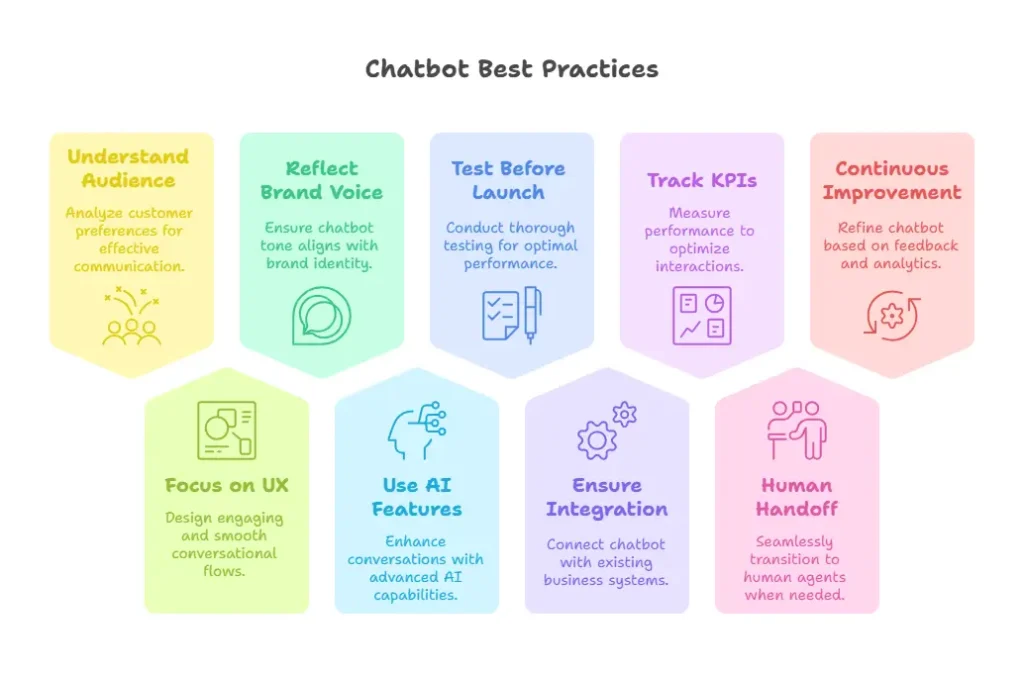Chatbots are transforming customer interactions by automating responses and improving service efficiency. A chatbot is a software application designed to simulate conversations, making it a key tool for customer support. However, simply using a chatbot for your business isn’t enough—without a solid chatbot strategy and proper chatbot development, it can lead to frustration rather than efficiency.
This guide covers essential chatbot best practices to enhance customer satisfaction, optimize chatbot interactions, and ensure seamless chatbot implementation. You’ll learn how to personalize chatbot conversations, test your chatbot, and track chatbot kpis to refine performance. By following these best practices, businesses can improve user experience, boost customer engagement, and create a chatbot that aligns with customer expectations.
9 Essential Chatbot Best Practices & Tips

1. Understand Your Audience & Choose the Best Communication Channels
A chatbot needs to communicate effectively with users, and that starts with understanding its audience. Businesses should analyze their customer base to determine how they prefer interacting with chatbots.
- Identify chatbot use cases based on common customer queries.
- Select the best communication channels for chatbot deployment.
- Ensure chatbot interactions align with customer preferences and behavior.
A chatbot provider should offer flexible chatbot solutions that adapt to different industries and use cases. Whether a chatbot works best on a website, mobile app, or messaging platform depends on where customers expect to find it.
2. Focus on Chatbot UX Best Practices & Conversational Flow
A chatbot that understands user behavior will provide a better chatbot experience. Chatbot UX best practices help businesses design bots that guide users smoothly through conversations.
- Use chatbot design techniques to create natural, engaging chatbot conversations.
- Avoid long-winded responses; make chatbot interactions clear and direct.
- Implement chatbot search functionality to help users find information quickly.
Best practices for chatbot design also include testing chatbot flows regularly to refine interactions.
3. Create a Chatbot That Reflects Your Brand Voice
A chatbot should sound like an extension of the business. Customers interacting with the chatbot should feel a consistent tone, whether they’re speaking to an AI chatbot or a human agent.
- Personalize chatbot conversations to fit the brand’s style.
- Maintain a professional yet approachable chatbot user experience.
- Use conversational AI to make chatbot interactions feel more human.
A chatbot strategy and deliver consistency across chatbot communications will boost customer trust.
4. Use AI Chatbot Features to Improve Conversations
An AI chatbot can leverage artificial intelligence to enhance customer experience. Businesses should explore advanced AI capabilities to make chatbot conversations more dynamic and effective.
- Use AI models to refine chatbot responses and improve customer engagement.
- Implement chatbot search to provide accurate information instantly.
- Leverage generative AI to create chatbot conversations that feel natural.
Using chatbots effectively requires optimizing AI experience and chatbot analytics.
5. Test Your Chatbot Before and After Launch
A chatbot requires ongoing testing to function properly. Businesses must test the chatbot under real-world conditions before launch.
- Test your chatbot using live interactions to refine responses.
- Implement chatbot kpis to measure chatbot effectiveness.
- Conduct A/B testing to determine which chatbot messages work best.
Testing chatbot interactions ensures it meets customer expectations and delivers a seamless user experience.
6. Ensure Seamless Integration with Business Systems
A chatbot can’t operate in isolation—it should integrate smoothly with existing business tools.
- Connect the chatbot with CRM, customer support platforms, and databases.
- Automate chatbot responses while maintaining human agent support when needed.
- Keep chatbot knowledge updated dynamically.
A well-integrated chatbot helps businesses streamline workflows and boost customer satisfaction.
7. Track Chatbot KPIs to Measure Success
Tracking chatbot KPIs is essential to understand chatbot performance. Businesses should analyze chatbot analytics to optimize chatbot interactions over time.
- Measure chatbot success using chatbot KPIs such as resolution rate and response time.
- Identify gaps in chatbot interactions and refine chatbot responses.
- Use chatbot analytics to track customer satisfaction and chatbot efficiency.
Monitoring chatbot KPIs will help businesses continuously improve chatbot experience and chatbot development.
8. Implement a Smooth Human Handoff Strategy
Not all inquiries can be handled by a chatbot. A chatbot solution should seamlessly transition customers to human agents when necessary.
- Define chatbot workflows for escalating conversations to live support.
- Ensure chatbot interactions are not frustrating when a human handoff is required.
- Maintain a balance between automation and human engagement.
A customer service chatbot that can transfer users effectively improves service experience and customer engagement.
9. Continuously Improve Your Chatbot Based on Customer Feedback
A chatbot needs constant refinement to stay relevant. Businesses should update chatbot responses based on chatbot analytics and user feedback.
- Refine chatbot messages to address common chatbot issues.
- Use chatbot KPIs to identify areas for chatbot improvement.
- Regularly update chatbot training data to improve chatbot accuracy.
By following chatbot best practices, businesses can build a chatbot that stays aligned with customer expectations and delivers a better service experience.
Conclusion
A successful chatbot requires careful planning, clear objectives, and continuous improvement. Businesses that implement chatbot best practices will help users have a better chatbot experience while improving customer satisfaction. By defining a solid chatbot strategy, selecting the right chatbot platform, and optimizing chatbot conversations, companies can ensure that chatbots enhance customer interactions rather than frustrate users.
Tracking chatbot KPIs, refining chatbot responses, and integrating chatbot analytics will help businesses measure and improve chatbot performance over time. Whether you are using chatbots for customer service, sales, or lead generation, ensuring seamless chatbot implementation will maximize their impact.
By following the best practices for chatbot success, companies can build a chatbot that not only streamlines operations but also enhances customer engagement and delivers personalized service. The right chatbot, when properly developed and continuously improved, becomes a powerful chatbot solution that meets evolving customer expectations.
FAQs
Q1: What are the different types of chatbots?
There are rule-based chatbots, AI-powered chatbots, and hybrid chatbots. Rule-based chatbots follow scripted workflows, AI chatbots use artificial intelligence to understand and respond to customer queries dynamically, and hybrid chatbots combine both approaches to optimize chatbot interactions.
Q2: How can I choose the right chatbot for my business?
Choosing the right chatbot depends on the chatbot use case and business needs. If your chatbot needs to handle simple customer support inquiries, a rule-based chatbot might be sufficient. For businesses requiring advanced AI experience, generative AI chatbots or conversational AI models can provide better chatbot engagement.
Q3: What’s the most important chatbot KPI to track?
Chatbot KPIs include response time, resolution rate, customer satisfaction scores, and chatbot engagement metrics. Businesses should use chatbot analytics to monitor chatbot performance and make data-driven improvements.
Q4: How do I ensure my chatbot aligns with my brand?
A chatbot should reflect your business’s tone, personality, and style. Personalizing chatbot conversations, maintaining consistency in chatbot responses, and integrating chatbot design into the overall brand strategy are key factors in aligning chatbots with a company’s identity.
Q5: Can chatbots replace human customer support?
No, chatbots cannot fully replace human customer support. A chatbot helps automate repetitive tasks and improves efficiency, but a human handoff strategy is essential for complex inquiries. Businesses should implement chatbots as part of a hybrid approach, ensuring that human agents are available when needed.



